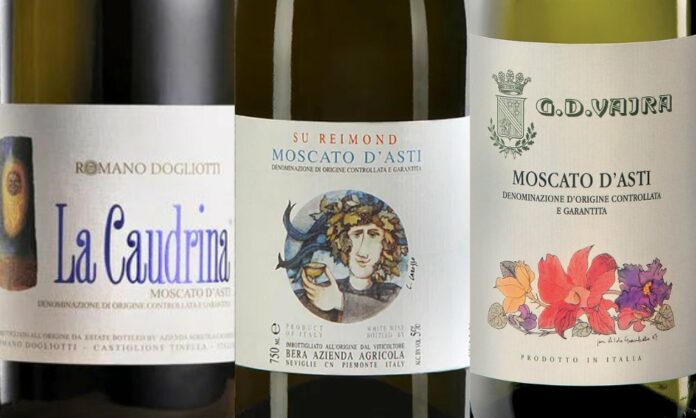
What are the best Moscato d’Asti? Discover the best Moscato d’Asti recommended by us with photos and descriptions. Do you want to tell us about a company and a Moscato d’Asti? Write to us
INDEX:
- Overview Moscato d’Asti in Italy
- Best Moscato d’Asti
- Moscato d’Asti pairings
BEST MOSCATO D’ASTI recommended by Jean Marco Palmieri

What are the best Moscato d’Asti?
Discover the Moscato d’Asti recommended by Italy’s Finest Wines with our tasting so that everyone can find the ideal Moscato d’Asti for their tastes and needs.
You will find many of the most iconic and historic companies but also those that have stood out for their unique and original character.
Moscato d’Asti ‘Su Reimond’ 2021 – Valter Bera

Characteristics:
A complex and layered aromatic range. Rose petals and ylang ylang are followed by tropical notes of ripe yellow fruit and litchi, on a base of nutmeg, honey and oriental scents of saffron. The sip is soft and seductive, with a nice savory tone that gives smoothness. Closing on honey and hazelnuts of surprising persistence.
Su Reimond is a cru located completely to the south, where Moscato vineyards have thrived on clay-tuff soil rich in limestone for more than forty years.
Fully one of the best Moscato d’Asti. Vertical, spicy, characterized by a riot of exotic fruit and oriental notes. A Moscato d’Asti that will seduce even the most demanding of connoisseurs.
Residual sugar: 130/g/l
Moscato d’Asti 2021 – La Caudrina

Characteristics:
Exotic fruit, peach, apricot and pineapple, combined with honey and orange blossom flowers. The sip is enveloping, characterized by a marked acidity that gives freshness and elegance.
Caudrina Moscato d’Asti is produced with Moscato Bianco grapes from vineyards at 280 meters above sea level on marly-limestone soils. After manual harvesting, the must undergoes filtration and fermentation in an autoclave at a controlled temperature with selected yeasts. Winemaking and bottling take place in isobaric conditions to preserve the freshness of the wine.
La Caudrina’s Moscato d’Asti is a ‘must’, one of the best Moscato d’Asti, known and appreciated throughout the world. Without a doubt among the best, an unforgettable sensory experience.
Residual sugar: nd
Moscato D’Asti 2021 – G.D.Vajra

Characteristics:
Brushstrokes of orange blossom blend with echoes of pine resin, maple syrup and candied ginger. On the palate it reveals a light effervescence, well integrated by acidity and sweetness. Very fine, enveloping closure with a finish on the fruit.
Moscato is harvested in the first half of September and undergoes a decantation process at low temperatures before fermentation which lasts for 7 days. Subsequently, it is kept in steel containers in order to preserve its natural effervescence.
Vajra has created a unique Moscato, a complex liquid nectar with refined aromas. Fully among the best Moscato d’Asti for structure, complexity and longevity.
Residual sugar: 130/g/l
Moscato d’Asti DOCG 2020 – Bera Vittorio e Figli

Characteristics:
Apricot, figs and citrus peel blend with notes of toasted almonds, dehydrated dates and sweet spices. On the palate it is soft and full-bodied, it seduces with an excellent freshness that makes the sip slim.
Gentle pressing, static defecation, spontaneous fermentation in autoclave, fermentation block and refinement in the same container.
Produced by one of the best artisan wineries in Asti, Moscato d’Asti by Bera Vittorio e Figli is deep and intense, with a marked minerality that makes it even more seductive. Fully among the best Moscato d’Asti for aroma and length.
Residual sugar: 140/g/l

Moscato d’Asti Canelli Sant’Ilario 2020 – Ca’ d’ Gal
Characteristics:
Notes of crunchy white fruit mix with hints of saltiness and medicinal herbs. On the palate it is pressing, sweet and savory, with amazing length.
The ‘Sant’Ilario’ represents a sumptuous interpretation of Moscato d’Asti, coming from vineyards with an average of 70 years of age.
A virtuous interpretation of Moscato with sensational freshness and drinkability. Among the best Moscato d’Asti for versatility in food pairing.
Residual sugar: nd
Moscato d’Asti Canelli Pianbè dei Surì 2020 – Pianbello

Caratteristiche:
Fiori bianchi, fiori di campo, pesca sciroppata e mineralità suadente. Il sorso è equilibrato, fresco e di grande persistenza.
Dopo la pigiadiraspatura sotto gas inerte, il mosto subisce una macerazione pellicolare di 12 ore. Segue una pressatura delicata e una fermentazione lenta a 12°C per raggiungere il grado alcolico di 5,5. Il vino viene stabilizzato a freddo e imbottigliato nell’inverno successivo alla vendemmia in bottiglie da 75 cl di tipo “Ellenica Maya”.
Il Moscato d’Asti di Pianbé dei Surì è tra i migliori Moscato d’Asti italiani per complessità e mineralità.
Residuo zuccherino: 140/g/l
Moscato d’Asti DOCG 2021 – Cascina Castlèt

Characteristics:
White flowers, wildflowers, peach in syrup and mellow minerality. The sip is balanced, fresh and very persistent.
After crushing-destemming under inert gas, the must undergoes a 12-hour skin maceration. This is followed by delicate pressing and slow fermentation at 12°C to reach an alcohol content of 5.5. The wine is cold stabilized and bottled in the winter following the harvest in 75 cl ‘Ellenica Maya’ bottles.
Pianbé dei Surì’s Moscato d’Asti is among the best Italian Moscato d’Asti for complexity and minerality.
Residual sugar: 140/g/l
Moscato d’Asti 2021 – La Gironda

Characteristics:
Lychees and candied citrus peel combine with delicate balsamic and patchouli notes. The sip is persistent, fresh and very clean.
Delicate pressing with separation of the must from the skins, followed by a rest period at low temperatures and fermentation in an autoclave.
La Gironda’s Moscato d’Asti is among the best Italian Moscato d’Asti for personality and elegance.
Residual sugar: 130/g/l
Sorì Eroici Moscato d’Asti DOCG 2021 – Poderi Roccanera

Characteristics: Exotic fruit, honey, acacia flowers and a touch of toasted almond. On the palate it is fresh, savory and very balanced.
Fermentation in autoclaves gives the natural effervescence to Moscato d’Asti. Before bottling, microfiltration is performed for clarity and stability of the wine.
Podere Roccanera’s Moscato d’Asti is among the best Italian Moscato d’Asti for refinement and minerality.
Residual sugar: 130/g/l
Moscato d’Asti DOCG Dolce Rita 2021 – Lodali

Characteristics: White flowers, wild flowers, peach in syrup and mellow minerality. The sip is balanced, fresh and very persistent.
The Moscato grapes are harvested by hand and then vinified in an autoclave using the Charmat method. The wine is aged in the bottle for a period of 3 months before being put on sale on the market.
Lodali’s Moscato d’Asti is among the best in terms of drinkability and immediate character. Excellent value for money.
The Moscato d’Asti of the Lodali winery originates in the vineyards located in the municipality of Treiso.
Residual sugar: ND
Moscato d’Asti 2021 – Emidio Vada

Characteristics: Exotic fruit, acacia flowers and notes of herbal tea. On the palate it is fresh, sweet and persistent, with a savory finish that gives character and length.
Fermentation begins with a rise in temperature, during which the yeasts transform the sugar into alcohol until reaching an alcohol content of 5%. At this point, to obtain a perfect balance between acidity, sugars and alcohol, fermentation is interrupted by lowering the temperature.
From the virtuous artisan cellar Emidio Vada, among the best Moscato d’Asti for personality and taste-olfactory balance.
Residual sugar: 160 g/l
Moscato d’Asti 2021 – Gianni Doglia

Characteristics: Seductive bouquet of white flowers, green apple, yellow peach and jasmine. On the palate it is fresh, savory and very balanced. Long persistence.
The grapes from their vineyards are harvested manually, delicately pressed and the must is refrigerated until processed in an autoclave. Controlled fermentation with selected yeasts leads to an alcohol content of 5%. Next, the wine is filtered and bottled, resulting in a lively wine with strong varietal characteristics.
The Moscato d’Asti from the family-run winery Gianni Doglia is among the best Italian Moscato d’Asti for elegance and pleasantness.
Residual sugar: ND
MOSCATO D’ASTI
Moscato d’Asti is a DOCG sparkling white wine produced in the province of Asti in northwestern Italy. Notoriously sweet and light, it is often a dessert wine. In the same region Asti is also made with the same grapes.
Ancient Roots: Originating from the hills of Asti in Piedmont, Moscato owes its name to its earthy aroma. Popular since the Middle Ages, it was made with Muscat à Petits Grains, known as white Muscat, in different variations, from dry to sweet like honey.
History and Production: Cultivated for centuries in Piedmont, white Moscato is one of the oldest vines. Modern production began in the 1870s, becoming a sparkling wine for light meals and an after-work digestif.
Art of Winemaking: The grapes grow in a region with limestone and sandstone soil. They are harvested when they contain the right level of sugar, then the fermentation process is stopped to maintain the low alcohol content of 5.5%. It does not have a second fermentation in the bottle.
A Popular Wine: Moscato d’Asti has become popular in the US, with sales growing 73% between 2011 and 2014, especially among young people. Its affordability and mention in hip-hop songs, for example by Trey Songz and Drake, have contributed to its popularity.
In conclusion, Moscato d’Asti is a fascinating wine with a rich history and a wide range of flavors. From its ancient roots to modern success, it is a delightful choice for exploring Italian wines.
FOOD PAIRING MOSCATO D’ASTI
Moscato d’Asti is a versatile wine that can be enjoyed on multiple occasions and paired with a variety of dishes. Traditionally known as a dessert wine, this crisp, aromatic wine is a perfect companion for a wide range of flavors.
Sweets and Desserts: Moscato d’Asti goes beautifully with sweets. From classics such as hazelnut cake, biscuits, panettone, or tarts to more imaginative preparations such as semifreddos, fruit salads, filled cakes and ice creams, this wine emphasizes the sweetness of desserts and completes their fragrance. It is recommended to serve it cold, at a temperature between 6 and 8 degrees, for sparkling wines, and between 10 and 12 degrees for still wines or dessert wines.
Savory Dishes: If you’re looking for a bold culinary experience, don’t be afraid to pair Moscato d’Asti with savory dishes. It’s surprising how its flavor profile can contrast and harmonize with savory flavors. Try enjoying it with quality cured meats and sausages, which offer a pleasant contrast between the sweetness of the wine and the saltiness of the meat. Aged cheeses are another excellent choice, as Moscato d’Asti can soften their robust flavors.
International Cuisine: Don’t limit yourself to Italian traditions. Moscato d’Asti can also pair well with oriental cuisine specialities, fish or white meat dishes, oysters and spicy preparations. This wine will surprise you with its versatility and its ability to adapt to a wide range of world cuisines.
Summer Drink: Thanks to its moderate alcohol content and its refreshing effervescence, Moscato d’Asti is an excellent drink for the summer months. It is ideal for cooling off on a hot day and can be enjoyed alone or with light dishes.
What are the best Moscato d’Asti?

What is the best Moscato d’Asti? Choosing is an arduous undertaking, which however is inevitably subject to the limits of a subjective opinion, which as such, by definition, is deficient and arbitrary.
We have simply drawn up a list of our favorite interpretations according to our evaluations. However, it remains essential to underline that wine is not created to be prestigious, exhibited or shown off.
But to get excited and be shared in a genuine way with the people we love, connecting to contingent situations and the unrepeatable and intimate moments of our lives.
Therefore, we invite you to visit wineries and get to know the producers who produce wines in their uniqueness, so that you can discover and independently choose the wine that canbe counted among your personal favorite wines for you. If you have had the patience to read this far, I thank you for your attention, but now is the time to fill the glasses and cut off distant hopes, and therefore:
Cheers, Health, Santé





